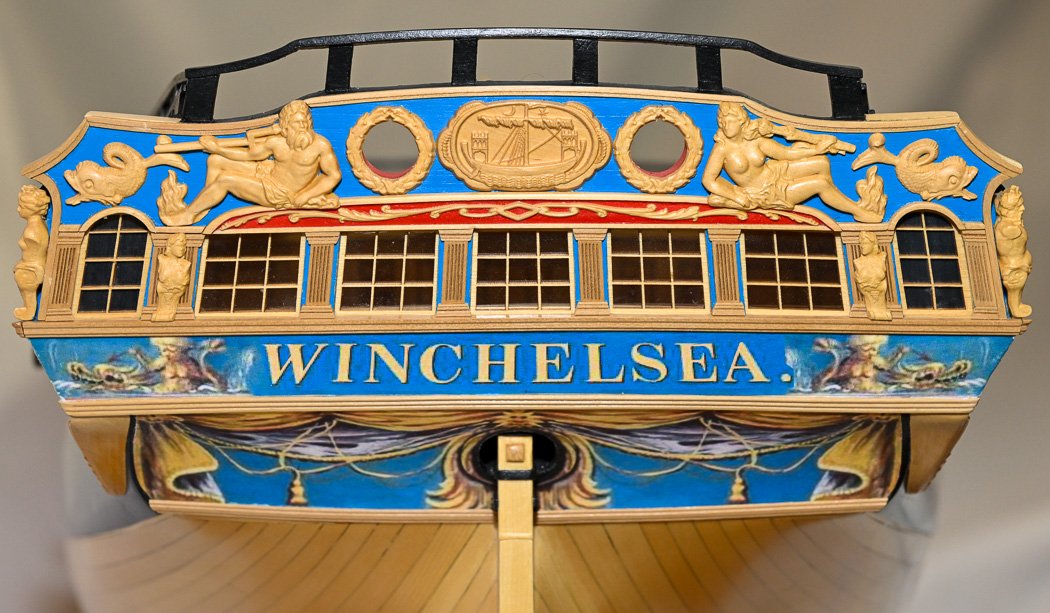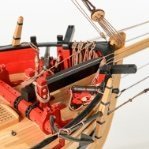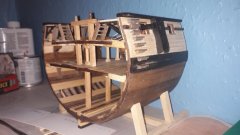MORE HANDBOOKS ARE ON THEIR WAY! We will let you know when they get here.
×
-
Posts
4,076 -
Joined
-
Last visited
Reputation Activity
-
 glbarlow got a reaction from Saburo in HM Cutter Cheerful 1806 by glbarlow - FINISHED - 1:48
glbarlow got a reaction from Saburo in HM Cutter Cheerful 1806 by glbarlow - FINISHED - 1:48
Thanks Bob! I'm not sure its that good, but I hope it helps future builders applying Chuck's methods.
Not sure about the good results part given I had to add a strip to the last bulkhead. Laying the batten along the length is the way to go. I think using a very thin one helps suss out problem areas. I also left the trailing edge with the laser char (forward aft of mid-ships, back of fore of midships). I sanded that off too at the end, but until then it made sure I didn't loose the shape of the hull. Even though I had a small problem I was able to fix, overall the planks run true. Honestly I don't know how to catch the last frame. It didn't become apparent until I installed the stern frames. Experience is the constant process of learning I guess.
-
 glbarlow got a reaction from Saburo in HM Cutter Cheerful 1806 by glbarlow - FINISHED - 1:48
glbarlow got a reaction from Saburo in HM Cutter Cheerful 1806 by glbarlow - FINISHED - 1:48
Thank you!
I borrowed it from someone else, it's all yours now 🙂
-
 glbarlow reacted to Edwardkenway in HM Cutter Cheerful 1806 by glbarlow - FINISHED - 1:48
glbarlow reacted to Edwardkenway in HM Cutter Cheerful 1806 by glbarlow - FINISHED - 1:48
What a great idea, I'll borrow that if I may.
Cheerful is looking really good, your planking is very tidy and looks perfect with the wop finish 👍
-
 glbarlow reacted to BobG in HM Cutter Cheerful 1806 by glbarlow - FINISHED - 1:48
glbarlow reacted to BobG in HM Cutter Cheerful 1806 by glbarlow - FINISHED - 1:48
Fantastic post on planking, Glenn! I think it's so good that the moderators should pin it along with the other instructions they have on planking.
You are 100% correct about this step. I think I'm doing better with sanding the hull so that the planks run fair but I'm still am not sure when I should sand a bit more or when I have sanded too much. Have you found a method that gives you consistently good results fairing the hull?
Gorgeous boat, by-the-way...
-
 glbarlow got a reaction from Freebird in HM Cutter Cheerful 1806 by glbarlow - FINISHED - 1:48
glbarlow got a reaction from Freebird in HM Cutter Cheerful 1806 by glbarlow - FINISHED - 1:48
I’ve built a number of models but taking on Cheerful is a new challenge. Before I started there were a number of tasks that were concerning for me. From port sills, thinning stern and bulkhead frames, square tucks to scarph joints, there are lots of things I’ve never attempted despite having built eight kits. On top of that list was single planking a hull that will be left natural (other than poly). No place to hide major mistakes and not much way to hide small ones. I’ve now finished the upper belt of the port side and thought I’d share what I did and what I learned.
@Chuck, as I’ve noted throughout this log, provides great instruction in his monograph. However, reading and doing are two different things. The first critical planking step happened months ago, fairing the hull. Taking the time to do that right back in the beginning now pays off.
Now its time to divide the hull into two belts. This keeps the measurements accurate and planking consistency more manageable. It starts by measuring from bulkhead zero (midships) the distance of 8 full planks (using the planking fan), since the known is full width planks at the center - that’s the first attachment point for the tape, then it’s connecting that to the stern and bow.
I struggled with this simple step of adding the artist tape (perfect for this job) to create the belts. I applied and re-applied tape until it wouldn’t stick and then did it again with more tape. I was being too analytical in how I was approaching positioning the tape. It wasn’t until I got some (more) sage advice from @Chuck I understood to step back and look at it straight on from the side and find the graceful curve (it’s there, let it come to me…be the hull…) and flow from bow to stern. And I mean from the side straight on. When you tilt the hull up to apply the tape it presents a false look of the tape flow, at least to my eyeballs - the curve doesn’t present itself until you lean back and look directly from the side at the balanced hull. Having found the curve, I marked lines on each bulkhead and threw away the tape I’d spent so much time moving around. The marks define how those 8 planks will fit the length of the ship and where and how much tapering I’ll do to make it fit, obviously thinner at the bow.
Then it’s time to line the hull. Chuck has .pdfs and videos here on the forum so I won’t go in to detail, I can’t begin to explain it as well as he can. I will say making tick strips and using the planking fan is precise and tedious work, but it’s time well spent and essential to success. It takes the guesswork out of planking.
Another key to these tick marks is not only the width at the bow but as important where to start the taper. In the case of Cheerful that was bulkhead 6. I kept the same starting point for all eight planks which turned the curve I created with the tape into a wooden reality.
-2552
Here I have a plank tapered and angled properly to fit the rabbit. Transferring those tick strips to each bulkhead and then to planks is how you get to consistent. The most critical of course is the bow - determining how wide strips need to be for 8 to fit within the tape mark. Often its also true of the stern, but the lining process (and Chuck’s monograph) noted for Cheerful this first belt from mid-ship to the square tuck it is full width planks. The other nice thing about these tick marks is the reassurance as I planked I was still on plan, still I double checked the measurement at the bow every other plank. I did have to make a few minor adjustments due to less than perfect tapering.
Then it’s on to my bending station. Again @Chuck monograph, .pdfs, and videos explain this. I can only add that in my view there is no better way to achieve a tight fit. No soaking, just a wipe of water across the plank with my wet finger and then a hot iron. It’s surprising just how much the wood can bend. It’s counter-intuitive but I bent the plank down in order for it to curve up on the bow. Then when that’s done bend it again to follow the inward curve. The wood can take it, just go slow and careful. Multiple times I bent the wood more than once (I only snapped one) to get a fit. It should almost lay into the bulkheads on its own.
I am also following the planking plan for proper lengths and pattern (rather than running one plank for the full length of the hull). I first added some edit marks to the plan (hard to see with those skinny lines) then transferred that to hash marks on the hull to maintain (well, actually not forget) the pattern. Another note: The plan is a two dimensional view of a three dimensional hull, don’t be deceived by the plank widths shown on the plan, that’s obvious when you think about it. Visually I was initially thinking I can take the width shown on the plan, nope. It works above the wales but not below.
I will own up to one cheat. For the short joints near the bow I scored a joint line on a longer plank that reached the second joint end nearer mid-ships. Tapering, bending, and fitting a single plank at the bow is hard enough, getting a match with a short plank was more than I wanted to do. Hence my joints at a the bow are perfect…because its the same plank.
Here's an example of how tilting the hull up may throw off my look at the curve. It may seem wobbly, it isn't. It's sort of an optical illusion because of the multiple curves at play, I had to ignore this and trust the tick marks.
I spent a long time on each individual plank, way more than any plank on any ship I’ve built before. I can’t make it up with paint or on a second planking. Here’s a little fun fact; different planks that measures 3/64ths on my digital caliper can measure between 1.18mm and 1.31mm. That’s not much, but it makes a difference on getting a smooth fit between planks. So now I measure the thickness on every plank in millimeters even though I cut them in imperial, its that or sand it out later. And I’m learning to do a better job with ripping planks.
After tapering, each plank is first beveled along the top edge and also slightly at each end, especially at the rabbet. This is a time consuming but important step for me to get a tight fit. The stern, due to the big curve from side to bottom (great use of nautical terms) is particularly challenging to get the right bevel and the right bends (more of a twist than a bend actually). It’s tempting to force it, it’s better to take the time.
I should be clear here. There are eight rows of planks in this belt. I probably made at least 14, tossing away almost as many as I fit. It’s another example that if my ship had three sides my third side would look great, I learn as I go.
Then it’s gluing them on. I placed CA with my thin applicator on no more than 2-3 bulkheads at a time and finger clamp the plank down and up for 20-40 seconds. That of course means as I moved along the plank would be too close to the bulkhead to use the applicator. I’m big fan of dental tools - here’s one I use to slip CA under the plank. I don’t glue the top edge. The bevel is how I get the fit, not edge glue.
While the tick marks confirmed I was on the right track, it was nonetheless nice to see the 8th and final plank fit at the stern right where it’s supposed to be as part of the eventual square tuck. I left them all a little long at the stern to give me some latitude when I get to the square tuck. I’d already had to make adjustments to the square tuck by sanding the triangle base down (again with advice from Chuck) to provide the 1/8th inch depth between it and the counter for the square tuck. After all that I repainted the wales, they got a bit banged up.
And I got to here following a light coat of poly (which isn’t fully dried and buffed yet in these photos) In addition to other things the poly brings out the seams and joints between the boards in a nice way.
I didn’t get a perfectly tight fit in the rabbit, so I helped myself by putting the slightest amount of super phatic glue with a toothpick (it dries clear) then added some sawdust taken from beneath my saw and packed it in at the rabbet. After light scraping (another dental tool) and sanding to remove the excess glue, with the poly added it now looks fine.
I’m happy with the curve of the stern, though maybe it’s a little flat. As I’ve noted earlier the initial fairing is critical, but I did over-sand the final bulk head. Layering a 1/64th strip (that’s all it took) on between bulkhead and planks created a smoother run. It took work, especially on beveling, to get a tight fit together with a tight twist that would have been very difficult without my handy travel iron.
It’s not perfect - it has flaws, I mean character, but I can’t see through it so there’s that. I like the slightly different colors of wood that comes from following the planking pattern, just more character.
I have 24 more planks to go to finish the hull so everything can still fall apart. But at least I’ve proven to myself that I can more or less single plank a ship - with the help of Chuck’s monograph, the process of lining the hull and bending planks, and a lot of time and patience (and possibly a supplemental wood order).
So as it turns out, I can get there from here.
-
 glbarlow got a reaction from Saburo in HM Cutter Cheerful 1806 by glbarlow - FINISHED - 1:48
glbarlow got a reaction from Saburo in HM Cutter Cheerful 1806 by glbarlow - FINISHED - 1:48
I’ve built a number of models but taking on Cheerful is a new challenge. Before I started there were a number of tasks that were concerning for me. From port sills, thinning stern and bulkhead frames, square tucks to scarph joints, there are lots of things I’ve never attempted despite having built eight kits. On top of that list was single planking a hull that will be left natural (other than poly). No place to hide major mistakes and not much way to hide small ones. I’ve now finished the upper belt of the port side and thought I’d share what I did and what I learned.
@Chuck, as I’ve noted throughout this log, provides great instruction in his monograph. However, reading and doing are two different things. The first critical planking step happened months ago, fairing the hull. Taking the time to do that right back in the beginning now pays off.
Now its time to divide the hull into two belts. This keeps the measurements accurate and planking consistency more manageable. It starts by measuring from bulkhead zero (midships) the distance of 8 full planks (using the planking fan), since the known is full width planks at the center - that’s the first attachment point for the tape, then it’s connecting that to the stern and bow.
I struggled with this simple step of adding the artist tape (perfect for this job) to create the belts. I applied and re-applied tape until it wouldn’t stick and then did it again with more tape. I was being too analytical in how I was approaching positioning the tape. It wasn’t until I got some (more) sage advice from @Chuck I understood to step back and look at it straight on from the side and find the graceful curve (it’s there, let it come to me…be the hull…) and flow from bow to stern. And I mean from the side straight on. When you tilt the hull up to apply the tape it presents a false look of the tape flow, at least to my eyeballs - the curve doesn’t present itself until you lean back and look directly from the side at the balanced hull. Having found the curve, I marked lines on each bulkhead and threw away the tape I’d spent so much time moving around. The marks define how those 8 planks will fit the length of the ship and where and how much tapering I’ll do to make it fit, obviously thinner at the bow.
Then it’s time to line the hull. Chuck has .pdfs and videos here on the forum so I won’t go in to detail, I can’t begin to explain it as well as he can. I will say making tick strips and using the planking fan is precise and tedious work, but it’s time well spent and essential to success. It takes the guesswork out of planking.
Another key to these tick marks is not only the width at the bow but as important where to start the taper. In the case of Cheerful that was bulkhead 6. I kept the same starting point for all eight planks which turned the curve I created with the tape into a wooden reality.
-2552
Here I have a plank tapered and angled properly to fit the rabbit. Transferring those tick strips to each bulkhead and then to planks is how you get to consistent. The most critical of course is the bow - determining how wide strips need to be for 8 to fit within the tape mark. Often its also true of the stern, but the lining process (and Chuck’s monograph) noted for Cheerful this first belt from mid-ship to the square tuck it is full width planks. The other nice thing about these tick marks is the reassurance as I planked I was still on plan, still I double checked the measurement at the bow every other plank. I did have to make a few minor adjustments due to less than perfect tapering.
Then it’s on to my bending station. Again @Chuck monograph, .pdfs, and videos explain this. I can only add that in my view there is no better way to achieve a tight fit. No soaking, just a wipe of water across the plank with my wet finger and then a hot iron. It’s surprising just how much the wood can bend. It’s counter-intuitive but I bent the plank down in order for it to curve up on the bow. Then when that’s done bend it again to follow the inward curve. The wood can take it, just go slow and careful. Multiple times I bent the wood more than once (I only snapped one) to get a fit. It should almost lay into the bulkheads on its own.
I am also following the planking plan for proper lengths and pattern (rather than running one plank for the full length of the hull). I first added some edit marks to the plan (hard to see with those skinny lines) then transferred that to hash marks on the hull to maintain (well, actually not forget) the pattern. Another note: The plan is a two dimensional view of a three dimensional hull, don’t be deceived by the plank widths shown on the plan, that’s obvious when you think about it. Visually I was initially thinking I can take the width shown on the plan, nope. It works above the wales but not below.
I will own up to one cheat. For the short joints near the bow I scored a joint line on a longer plank that reached the second joint end nearer mid-ships. Tapering, bending, and fitting a single plank at the bow is hard enough, getting a match with a short plank was more than I wanted to do. Hence my joints at a the bow are perfect…because its the same plank.
Here's an example of how tilting the hull up may throw off my look at the curve. It may seem wobbly, it isn't. It's sort of an optical illusion because of the multiple curves at play, I had to ignore this and trust the tick marks.
I spent a long time on each individual plank, way more than any plank on any ship I’ve built before. I can’t make it up with paint or on a second planking. Here’s a little fun fact; different planks that measures 3/64ths on my digital caliper can measure between 1.18mm and 1.31mm. That’s not much, but it makes a difference on getting a smooth fit between planks. So now I measure the thickness on every plank in millimeters even though I cut them in imperial, its that or sand it out later. And I’m learning to do a better job with ripping planks.
After tapering, each plank is first beveled along the top edge and also slightly at each end, especially at the rabbet. This is a time consuming but important step for me to get a tight fit. The stern, due to the big curve from side to bottom (great use of nautical terms) is particularly challenging to get the right bevel and the right bends (more of a twist than a bend actually). It’s tempting to force it, it’s better to take the time.
I should be clear here. There are eight rows of planks in this belt. I probably made at least 14, tossing away almost as many as I fit. It’s another example that if my ship had three sides my third side would look great, I learn as I go.
Then it’s gluing them on. I placed CA with my thin applicator on no more than 2-3 bulkheads at a time and finger clamp the plank down and up for 20-40 seconds. That of course means as I moved along the plank would be too close to the bulkhead to use the applicator. I’m big fan of dental tools - here’s one I use to slip CA under the plank. I don’t glue the top edge. The bevel is how I get the fit, not edge glue.
While the tick marks confirmed I was on the right track, it was nonetheless nice to see the 8th and final plank fit at the stern right where it’s supposed to be as part of the eventual square tuck. I left them all a little long at the stern to give me some latitude when I get to the square tuck. I’d already had to make adjustments to the square tuck by sanding the triangle base down (again with advice from Chuck) to provide the 1/8th inch depth between it and the counter for the square tuck. After all that I repainted the wales, they got a bit banged up.
And I got to here following a light coat of poly (which isn’t fully dried and buffed yet in these photos) In addition to other things the poly brings out the seams and joints between the boards in a nice way.
I didn’t get a perfectly tight fit in the rabbit, so I helped myself by putting the slightest amount of super phatic glue with a toothpick (it dries clear) then added some sawdust taken from beneath my saw and packed it in at the rabbet. After light scraping (another dental tool) and sanding to remove the excess glue, with the poly added it now looks fine.
I’m happy with the curve of the stern, though maybe it’s a little flat. As I’ve noted earlier the initial fairing is critical, but I did over-sand the final bulk head. Layering a 1/64th strip (that’s all it took) on between bulkhead and planks created a smoother run. It took work, especially on beveling, to get a tight fit together with a tight twist that would have been very difficult without my handy travel iron.
It’s not perfect - it has flaws, I mean character, but I can’t see through it so there’s that. I like the slightly different colors of wood that comes from following the planking pattern, just more character.
I have 24 more planks to go to finish the hull so everything can still fall apart. But at least I’ve proven to myself that I can more or less single plank a ship - with the help of Chuck’s monograph, the process of lining the hull and bending planks, and a lot of time and patience (and possibly a supplemental wood order).
So as it turns out, I can get there from here.
-
 glbarlow reacted to ccoyle in HMS Speedy by Delf - FINISHED - Vanguard Models - Scale 1:64 - Master Shipwright edition
glbarlow reacted to ccoyle in HMS Speedy by Delf - FINISHED - Vanguard Models - Scale 1:64 - Master Shipwright edition
Here ya go, Derek -- you're famous! One hundred likes already since just this morning. 👍
-
 glbarlow reacted to DelF in HMS Speedy by Delf - FINISHED - Vanguard Models - Scale 1:64 - Master Shipwright edition
glbarlow reacted to DelF in HMS Speedy by Delf - FINISHED - Vanguard Models - Scale 1:64 - Master Shipwright edition
Thanks Glenn. I’m not on Facebook so I hadn’t seen that - I’ll have to find out how to look at the MSW page.
I’m using Quadhands extensively for rigging the cannon. The magnets are very strong, and should be more than adequate for any rigging jobs.
Derek
-
 glbarlow got a reaction from Ronald-V in HMS Speedy by Delf - FINISHED - Vanguard Models - Scale 1:64 - Master Shipwright edition
glbarlow got a reaction from Ronald-V in HMS Speedy by Delf - FINISHED - Vanguard Models - Scale 1:64 - Master Shipwright edition
Congratulations Derek on your Speedy being featured on the MSW Facebook page!
My Fair American was featured recently. It’s nice to see our work shared, so thanks MSW.
-
 glbarlow got a reaction from FrankWouts in HMS Victory by James H - Amati - 1:64
glbarlow got a reaction from FrankWouts in HMS Victory by James H - Amati - 1:64
I’ll definitely be watching this and enjoy building it vicariously. No way am I interested in building something so large, but it will be fun watching you do it.
-
 glbarlow got a reaction from popeye the sailor in HMS Victory by James H - Amati - 1:64
glbarlow got a reaction from popeye the sailor in HMS Victory by James H - Amati - 1:64
I’ll definitely be watching this and enjoy building it vicariously. No way am I interested in building something so large, but it will be fun watching you do it.
-
 glbarlow got a reaction from hollowneck in HMS Victory by James H - Amati - 1:64
glbarlow got a reaction from hollowneck in HMS Victory by James H - Amati - 1:64
I’ll definitely be watching this and enjoy building it vicariously. No way am I interested in building something so large, but it will be fun watching you do it.
-
 glbarlow reacted to Blue Ensign in Lady Eleanor by Blue Ensign - FINISHED - Vanguard Models - Scale 1:64
glbarlow reacted to Blue Ensign in Lady Eleanor by Blue Ensign - FINISHED - Vanguard Models - Scale 1:64
Thanks Glenn, I'm pleased with how the sails turned out.
Get what you pay for I suppose Bob, I like them a lot, but that doesn't mean I'm not going to fiddle with them, as you will see below.😉
Post 27
Reef points and other tricky issues..
I have been thinking about reef points, these do not feature on the kit available sails, (didn't expect them to) but neither are they shown on the kit sail plans.
Several rows of reef points are appropriate to the sails on these large luggers and at 1:64 scale should really be included. Their absence is noticeable on the prominent sails of the Fifie model.
Several things have to be considered.
How many points on each sail.
How long are the points.
What is the vertical spacing of the points.
How to apply them to look natural.
I have used Harold Underhill’s scale drawings of the Zulu Muirneag as the basis for addressing these points.
The points are attached along the vertical seam lines of the sails. To begin I am attaching four bands on the Foresail and two on the Mizen.
I have scaled the points to a length of 14mm.
From the drawings I have worked on the basis that the tip of upper band is a fraction above the knot of the lower band.
Application of the points to the sail is an issue.
To do it properly a double length line is passed thro’ a hole in the sail and knotted at the top each side.
The issue with this is that getting them to hang naturally can be problematic without resorting to use of pva to hold them down on the sail.
This risks marking the previously dyed material.
I have decided to simply glue the points to the sail at the knot. This way the point lies flat, and the application of glue is better controlled.
6184(2)
The sail is taped down to get the line of the points.
6194
Two lines of points pva’d to the Mizen sail.
6190
I’m happy with the result.
6205
This method seems quite effective and is certainly a lot less time-consuming than feeding them thro’ the sail, adding knots, and then trying to persuade them to lie reasonably flat.
I also attended to attaching the parrels.
6200
Still only a temporary rig at present.
6202
The advantage of this simple lugger rig is that I can slip the yard/sails including the parrel over the masthead.
Moving on to fix the points to the larger Fore-sail.
B.E.
16/07/20
-
 glbarlow got a reaction from JeffT in HMS Speedy by Delf - FINISHED - Vanguard Models - Scale 1:64 - Master Shipwright edition
glbarlow got a reaction from JeffT in HMS Speedy by Delf - FINISHED - Vanguard Models - Scale 1:64 - Master Shipwright edition
Congratulations Derek on your Speedy being featured on the MSW Facebook page!
My Fair American was featured recently. It’s nice to see our work shared, so thanks MSW.
-
 glbarlow got a reaction from mtaylor in Chris Watton and Vanguard Models news and updates
glbarlow got a reaction from mtaylor in Chris Watton and Vanguard Models news and updates
Thanks, I’ll do my best to do so.
-
 glbarlow got a reaction from mtaylor in Chris Watton and Vanguard Models news and updates
glbarlow got a reaction from mtaylor in Chris Watton and Vanguard Models news and updates
My master Shipwright Flirt has been ordered, can’t wait to see it.
Just as a note my future build log will use James’ photos, otherwise I’ll just feel bad about myself 😂🤣😂🤣😂
-
 glbarlow got a reaction from Jonny 007 in Chris Watton and Vanguard Models news and updates
glbarlow got a reaction from Jonny 007 in Chris Watton and Vanguard Models news and updates
My master Shipwright Flirt has been ordered, can’t wait to see it.
Just as a note my future build log will use James’ photos, otherwise I’ll just feel bad about myself 😂🤣😂🤣😂
-
 glbarlow got a reaction from DelF in Chris Watton and Vanguard Models news and updates
glbarlow got a reaction from DelF in Chris Watton and Vanguard Models news and updates
My master Shipwright Flirt has been ordered, can’t wait to see it.
Just as a note my future build log will use James’ photos, otherwise I’ll just feel bad about myself 😂🤣😂🤣😂
-
 glbarlow reacted to chris watton in Chris Watton and Vanguard Models news and updates
glbarlow reacted to chris watton in Chris Watton and Vanguard Models news and updates
Oh, almost forgot, the 18' cutter is now available as a separate fitting
-
 glbarlow got a reaction from Martin W in Lady Eleanor by Blue Ensign - FINISHED - Vanguard Models - Scale 1:64
glbarlow got a reaction from Martin W in Lady Eleanor by Blue Ensign - FINISHED - Vanguard Models - Scale 1:64
Definitely got the color right on the sails, it all looks so color coordinated. The sail design seems so eloquently simple, nicely done.
-
 glbarlow got a reaction from BobG in Chris Watton and Vanguard Models news and updates
glbarlow got a reaction from BobG in Chris Watton and Vanguard Models news and updates
My master Shipwright Flirt has been ordered, can’t wait to see it.
Just as a note my future build log will use James’ photos, otherwise I’ll just feel bad about myself 😂🤣😂🤣😂
-
 glbarlow got a reaction from Blue Ensign in Lady Eleanor by Blue Ensign - FINISHED - Vanguard Models - Scale 1:64
glbarlow got a reaction from Blue Ensign in Lady Eleanor by Blue Ensign - FINISHED - Vanguard Models - Scale 1:64
Definitely got the color right on the sails, it all looks so color coordinated. The sail design seems so eloquently simple, nicely done.
-
 glbarlow got a reaction from BobG in Lady Eleanor by Blue Ensign - FINISHED - Vanguard Models - Scale 1:64
glbarlow got a reaction from BobG in Lady Eleanor by Blue Ensign - FINISHED - Vanguard Models - Scale 1:64
Definitely got the color right on the sails, it all looks so color coordinated. The sail design seems so eloquently simple, nicely done.
-
 glbarlow got a reaction from Ronald-V in Chris Watton and Vanguard Models news and updates
glbarlow got a reaction from Ronald-V in Chris Watton and Vanguard Models news and updates
My master Shipwright Flirt has been ordered, can’t wait to see it.
Just as a note my future build log will use James’ photos, otherwise I’ll just feel bad about myself 😂🤣😂🤣😂
-
 glbarlow got a reaction from Edwardkenway in Lady Eleanor by Blue Ensign - FINISHED - Vanguard Models - Scale 1:64
glbarlow got a reaction from Edwardkenway in Lady Eleanor by Blue Ensign - FINISHED - Vanguard Models - Scale 1:64
Definitely got the color right on the sails, it all looks so color coordinated. The sail design seems so eloquently simple, nicely done.






.jpg.d84ec4dad1d7791e855dca06210ab6f3.thumb.jpg.f45209242e851d4409eca1a09293165b.jpg)





